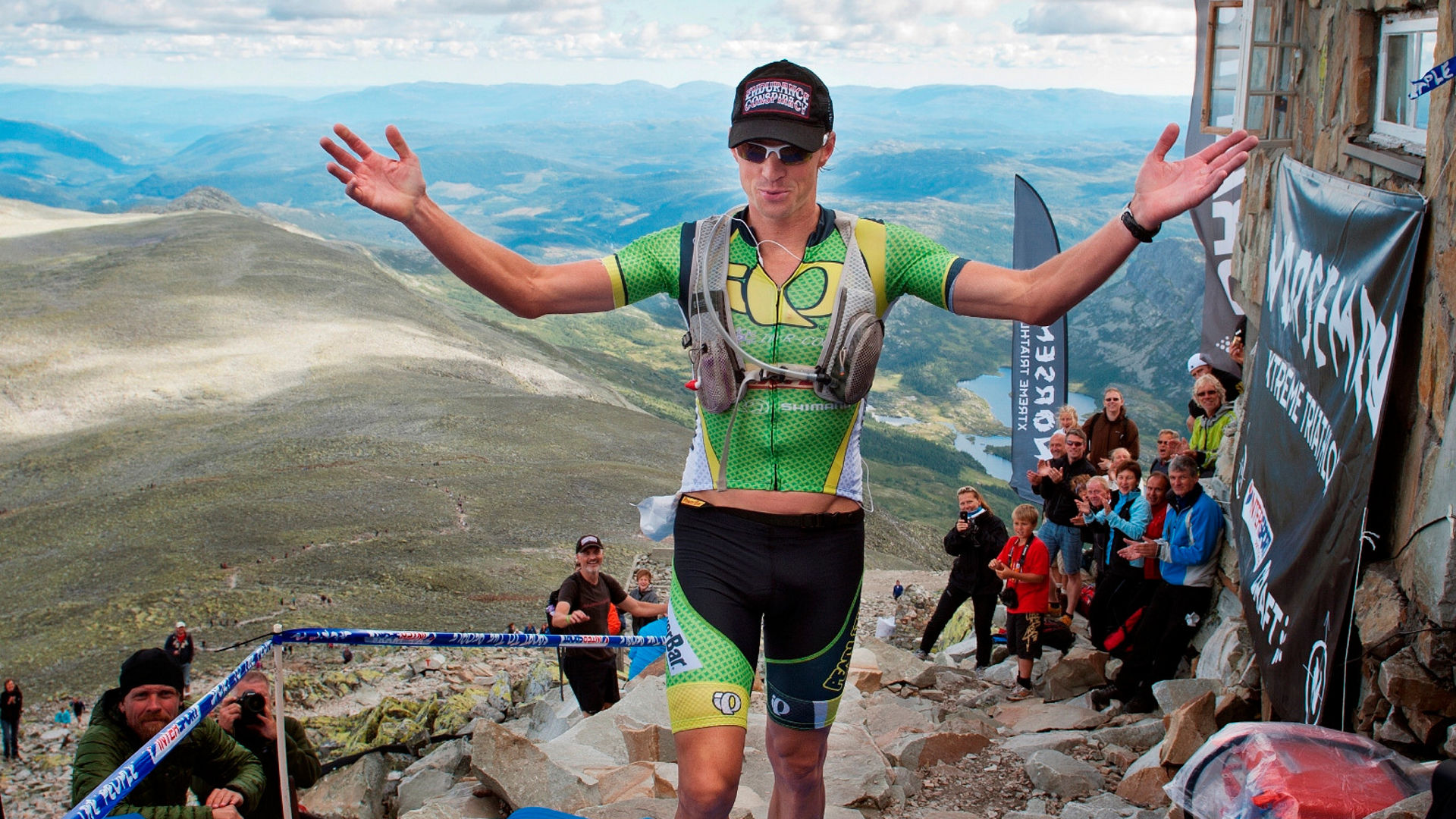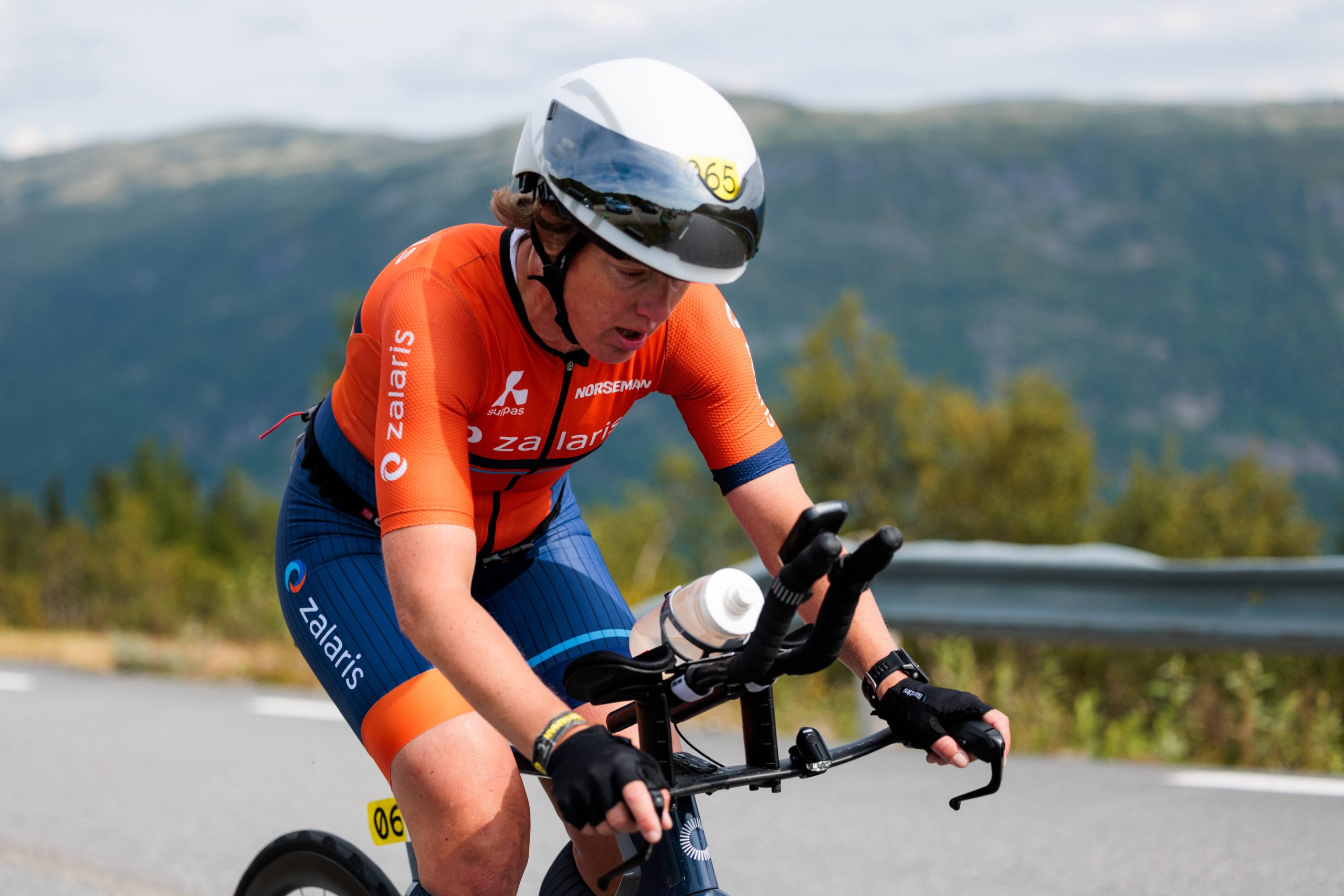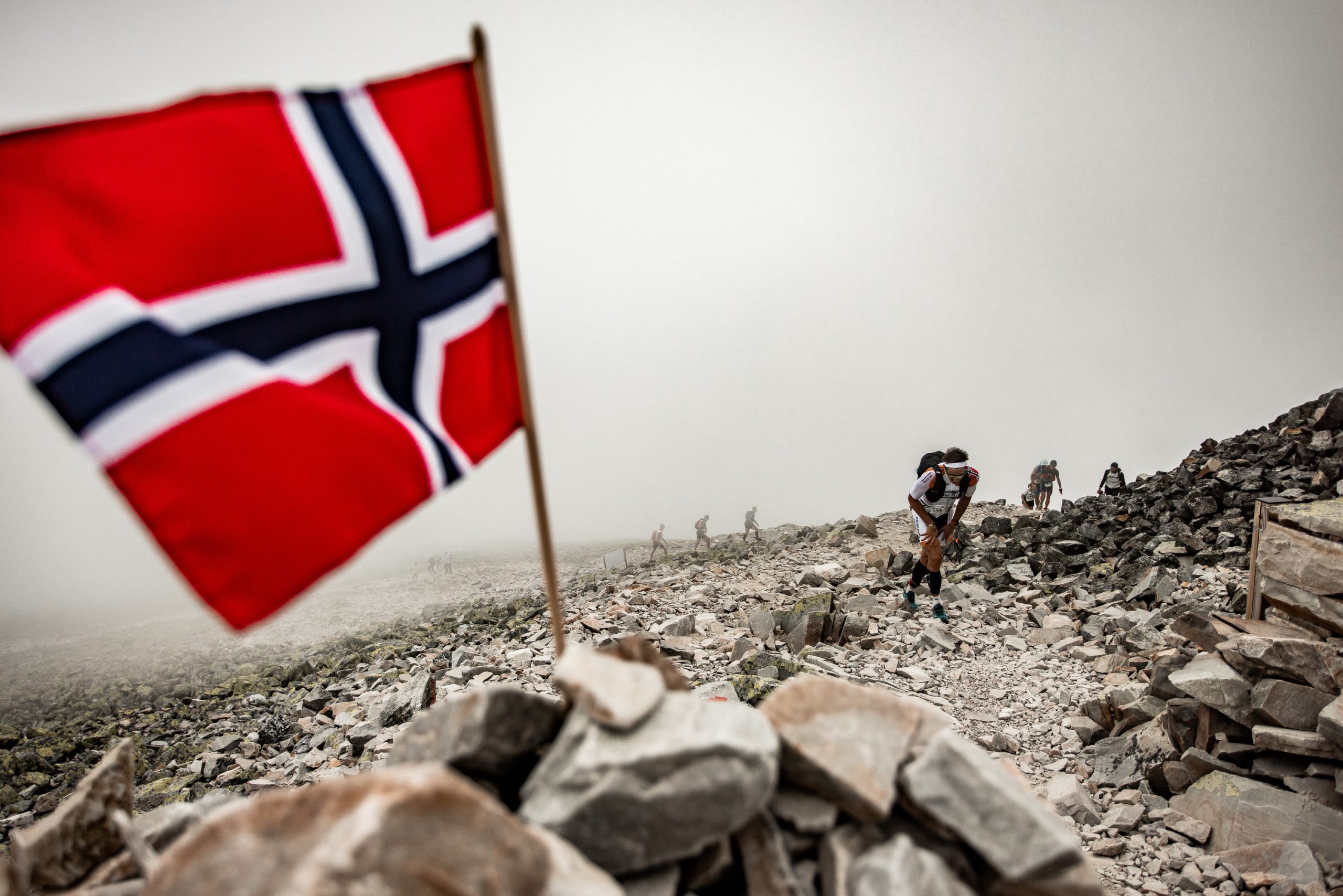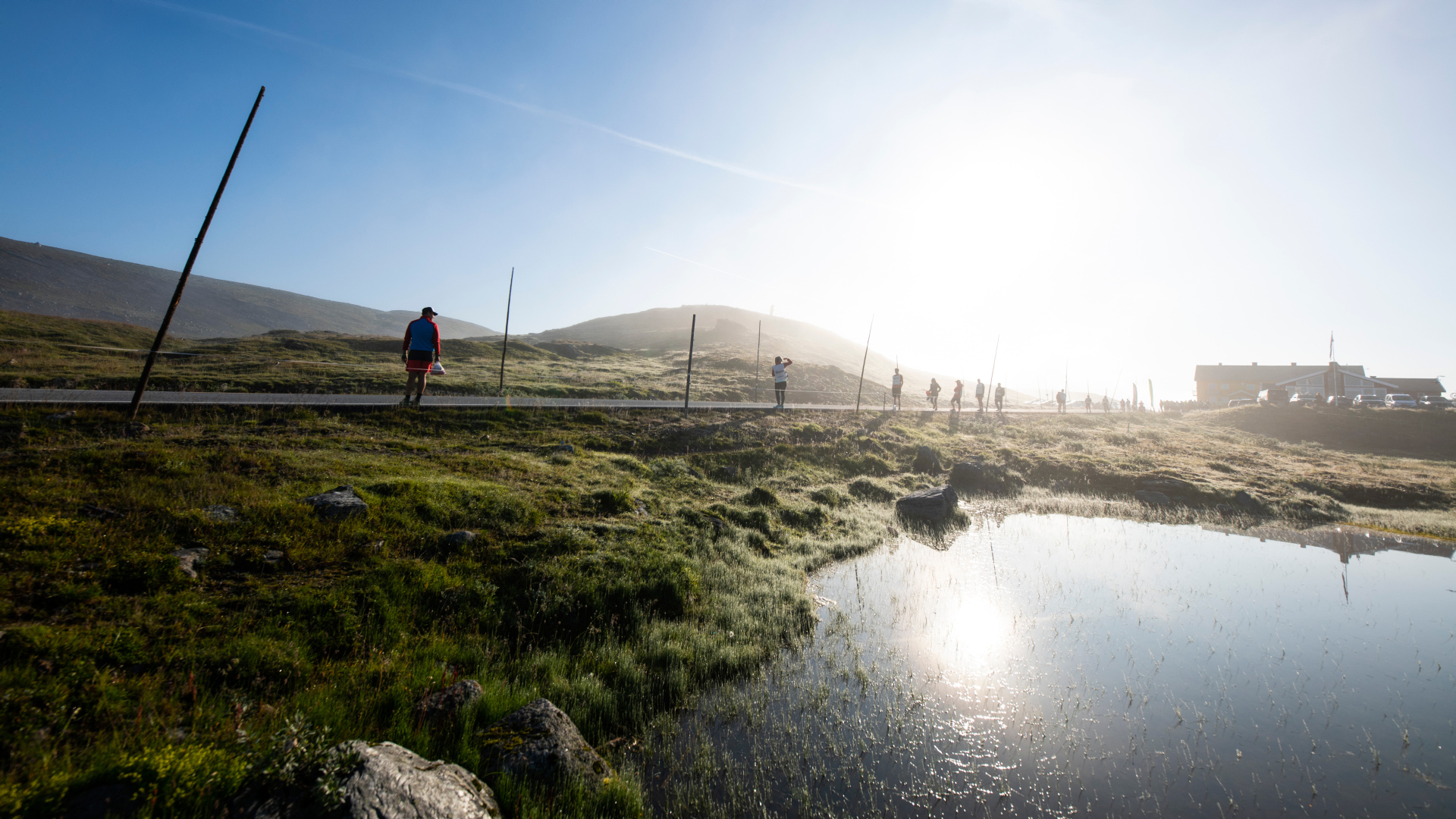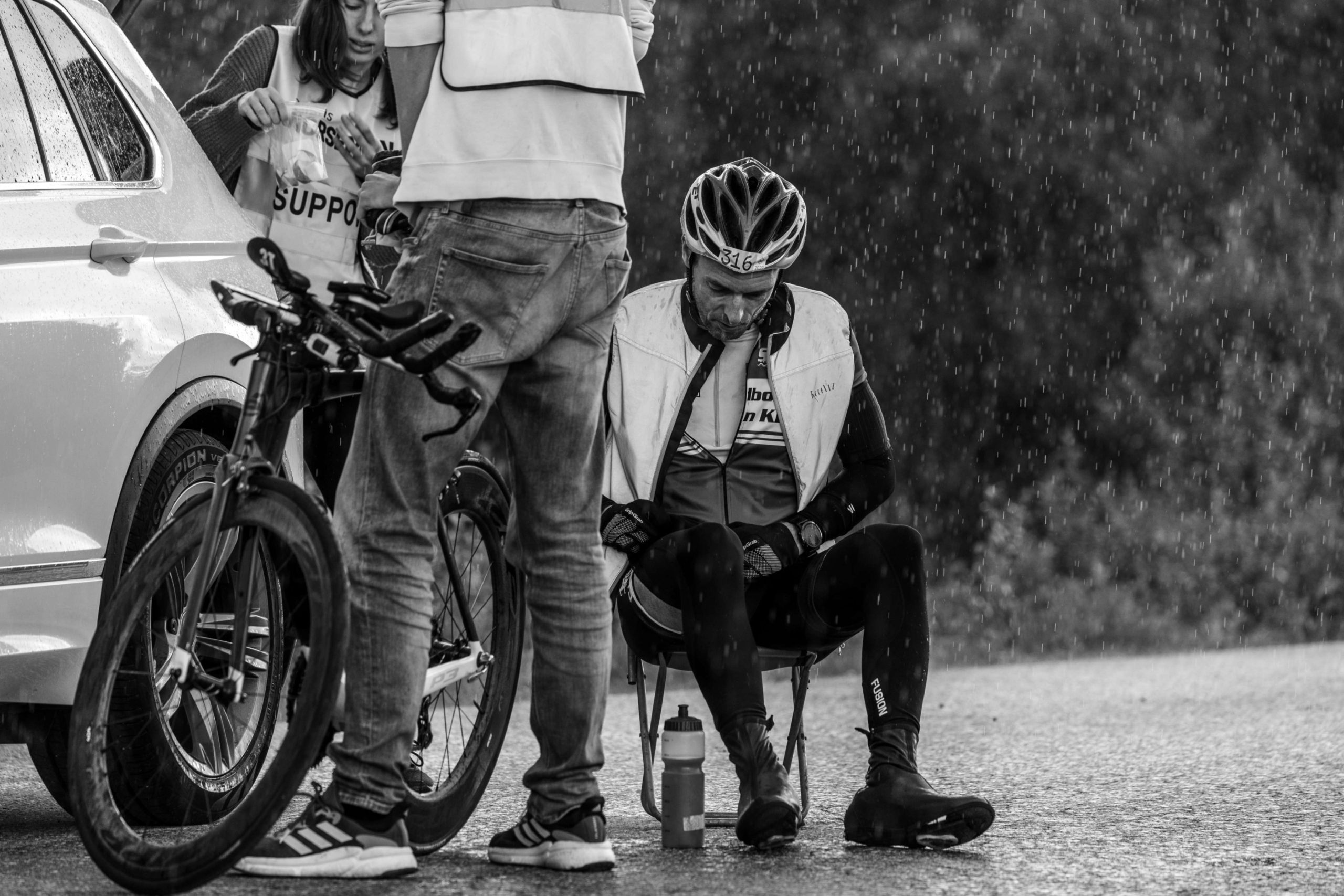He’s since been a stay at home dad, personally training people and adventuring in the Colorado mountains!
Today Tim shares with us his triathlon journey and experiences, and best Norseman training and racing recommendations.
In this short episode you’ll learn these key things:
- Tim’s journey to winning Ironman World Championships and Norseman
- What it’s like to win the Ironman World Championships Vs. Norseman
- How to best choose your Norseman support team and work together
- How to train for Zombie Hill
Listen to the episode on:
Scroll down for the full episode notes.
————
Adelaide: I’m really excited for today’s conversation with Tim DeBoom, who is a two times winner of the Ironman World Championships, Kona, Hawai`i in 2001 and 2002, and in 2011, Tim became the first non-European to win the Norseman Xtreme Triathlon! Welcome Tim to Norseman Radio. It’s so great to have you with us!
Tim: Thank you so much for having me. It’s my pleasure.
Adelaide: Would you tell us who you are and what you do in the world today?
Tim: My name is Tim DeBoom. I was a professional triathlete from the United States for almost 20 years. I haven’t been racing now for a little while, but I won the Hawai’i Ironman two times in a row in 2001 and 2002, and then I won Norseman in 2011.
Now I am kind of a jack of all trades! My daughter was born right after Norseman and I took a few years off to a kind of stay at home dad and went back to school for a little bit for some physical therapy type stuff, and since then, I’ve been personally training people and just really adventuring in the mountains and exploring more of Colorado, since I missed so much of it when I was racing full time.
Adelaide: That’s really amazing, so you’ve been on quite the journey?
Tim: I have and I’ve settled down quite a bit. I don’t really miss the travel anymore. I really, really enjoy staying here in Colorado. But I’d come back to Norway in a minute, I love that place.
Adelaide: I’ve recently moved here, so I can’t say enough good things about it!
Tim: Yeah, I didn’t get to go in winter and now I embrace the winter sports more than anything else, so I’m itching to come back.
Adelaide: Before we dive into your Norseman race, would you tell us how you got into triathlon in the first place and your journey to becoming a pro triathlete?
Tim: Well, I grew up as a competitive swimmer from about the age of six or seven.
I kind of followed my brothers into the sport of swimming and was a swimmer all the way until my first two years of university and as I’m competitive, I was a US nationally ranked swimmer – not anything on the world stage and had no chance of going to the Olympics, but good enough to swim in college and to be pretty good in my earlier school days.
I think once you realise in swimming, that you’re not going to make the Olympics, there’s not much of a professional sport kind of world to go into.
So I was just looking for something to keep my competitive drive going when I was done with swimming and I had some friends that had participated in triathlons. One in particular had been trying to qualify for the Ironman in Hawai’i for a number of years.
I just thought, well, maybe I’ll try a triathlon and I did one kind of on a whim and did really well! It was just a Olympic distance type race and I got second in that first race with a bunch of mistakes and I kind of just walked away. After that I didn’t do another race for a year. I just was like, well, I did a triathlon. It was great!
But, after about a year, I was hearing more and more about the Ironman and this is back in 1992, when you could qualify for the Ironman in Hawai’i by doing an Olympic distance race. It was a very, very different sport back then. So that’s what I did!
My second race was an Ironman qualifier. It was an Olympic distance race and I qualified as an age group athlete, and that kind of set me on my path.
I stayed racing the short distance stuff for quite a while, thinking that it was going to get in the Olympics and I kept waiting and waiting… By the time they finally announced it was going to be in the Olympics in 2000, I had kind of established myself almost as an Ironman athlete. I’d gotten third in Kona, and stuff like that, but you know, I turned pro just because I was racing in the age group ranks and beating most of the pros at the short distance races and realised that hey, maybe I could make a couple bucks doing this and you know, most to the chagrin of my parents, I left college with like eight credits left, like three classes to finish.
I moved to California and Colorado and started racing. That was kind of what got me into it and I had some success at the short distance right away in the pro ranks, but it took me a while to find myself at the Ironman distance.
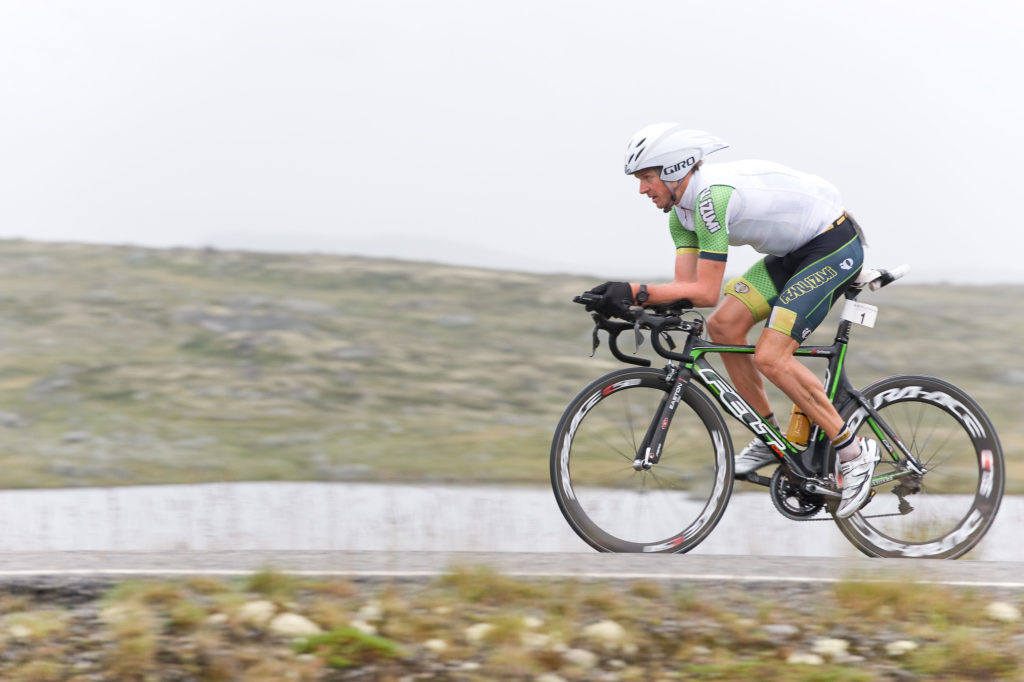
Adelaide: what made you think that when you were doing the Ironman racing that actually you wanted to take this a step further and become a pro triathlete?
Tim: Well, once you do Ironman, especially in Hawai’i and that was my first Ironman, nowadays you have to do different Ironmans, but my first three or four Ironmans were Hawai’i, so I didn’t really venture outside of that. And once you do it over there, it really grabs hold of you.
I wasn’t the kind of guy who like did it once and was like I’m done. That’s it. I did Hawaiʻi and wanted to go back and keep testing myself.
The first time I did it, it was ‘Can I do this? Can I finish this race?’ I was just a really young 20 year old and wasn’t sure what was going on. But I had some success at the short distance and was winning some money. And everybody just wanted to do well in Hawaiʻi at that point as professionals and I finally threw my hat in that ring. My first race as a professional in Hawaiʻi, I came 10th. So that kind of set me up to say, hey, maybe I can do something over here and a long winding path took me to almost 20 years later of a pro triathlon career.
Adelaide: When you started, did you think you could win the Ironman World Championship?
Tim: Absolutely not. It wasn’t even a wish. I couldn’t even go on runs and dream about it. I think everybody goes out and has these visions and that wasn’t even on my radar. When I first did Hawaiʻi, it was purely ‘Can I finish this race?’ and, ‘Boy, this would be neat to do.’.
I didn’t think I could really win until I got third over there and I had a lot of different things go wrong, and then I got second, and you just really don’t know you can win, or even think you can win, until you do it on the day. That was the way it happened for me at least.
Adelaide: When you were ranking second and third, and before that as well, was it something you wanted to win at?
Tim: Absolutely. The third place was kind of a surprise. I had been 10th a couple times and hadn’t quite put it together. I’d trained with Peter Reid who had won it and I had beat him in training, so I knew I could train hard enough to win. I just wasn’t putting all the puzzle pieces together.
In 1999, I finally kind of gave myself an ultimatum and said, ‘All right, I’m either going to step up and do something here, or I gotta walk away and find another career, because getting 10th in Hawaiʻi continuously just wasn’t what I wanted.’ I was there to do better and knew that I couldn’t make a living off getting 10th place in Hawaiʻi each year.
I made a few changes that year and just learned how to rest more. I could train with anybody, I could train harder than anybody, but learning how to rest and recover and do all the little things properly, is what really helped me in 1999, when I kind of surprised myself and got third!
Adelaide: When you won in 2001, what was that like?
Tim: I get that question all of the time! It’s hard to even describe! For the very first time a few months ago, I actually saw the finish on a video. I had never really watched it and it gave me goosebumps and almost made me tear up, because it was such a strong emotion. If you’re a triathlete, there’s absolutely nothing that compares running down the drive in first place. it’s hard to beat that emotion.
I crossed the line and had some good friends there. My mom was there at the finish line. My wife was out racing and was it was kind of just a culmination of everything I had put into the sport at that point. Plus we had the tragedy of 911, you know, just a month prior. It was pretty overwhelming emotion at that point.
Adelaide: Did you go back the next year with the same aim to win?
Tim: Yeah, definitely, because of the terrorist attacks and stuff like that, a lot of the companies who had put money into the sport and the marketing dollars had disappeared. My title sponsor that I won the race for dropped me. So I went into the next year after winning Ironman with no sponsors, because I just wasn’t going to take any bad deals.
I said, ‘All right, I’ll just race blank and I’ll go in and I’ll win again, and I’ll prove it to them.’
So I put everything into that one basket of winning Hawai’i again and it worked out!
I had a lot of external motivations that year, people saying it was kind of a fluke that I won and some new up and coming athletes kept saying that they were going to come in and dominate.
So I just put everything I could into that one race and it worked out pretty well.
Adelaide: How did winning for the second time compare to the first?
Tim: The second time was very satisfying. Like I said, it was when people doubted my win the year before and I got less respect. There wasn’t a lot of respect for me coming into that race and even today, I know I wasn’t the fastest triathlete out there. I didn’t set any records. I didn’t blaze the course. We had tough conditions and that suited me.
But on those two days in 2001 and 2002, I was the best there was and coming back and repeating the win, which not a lot of people do these days in any sport at a world championship level, 2002 was very, very special for me.
Adelaide: I can imagine, that’s pretty incredible. So between 2000 and 2011, when did Norseman come on your radar?
Tim: It didn’t come on my radar until much later, maybe 2009 or 2010. I started hearing about some of these crazy races and hearing a little bit more. By that point, my career was sliding a bit effort wise. It’s tough to go back to Hawai’i and not perform. I was searching a little bit for what was next.
The whole reason I got into triathlon and Ironman was to see if I could do it. It was to answer that big question: ‘Can I do something like this is? Am I physically capable and mentally capable of doing an Ironman?’
I think that’s what piqued my interest with Norseman. I was hearing about this event and how it was the toughest event in the world. That piqued my interest and slowly I started just saying, All right, this is what I’m going to do and you know, I contacted the race and it worked out well.
I was really excited. It gave me really strong motivation for a full year, which is what Ironman used to do for me. I used to base my year around that and knowing I was doing Norseman, I was just wondering, ‘Am I going to be able to do this? Can I finish this? What’s it going to be like?
So that was what really what drew me to Norseman.
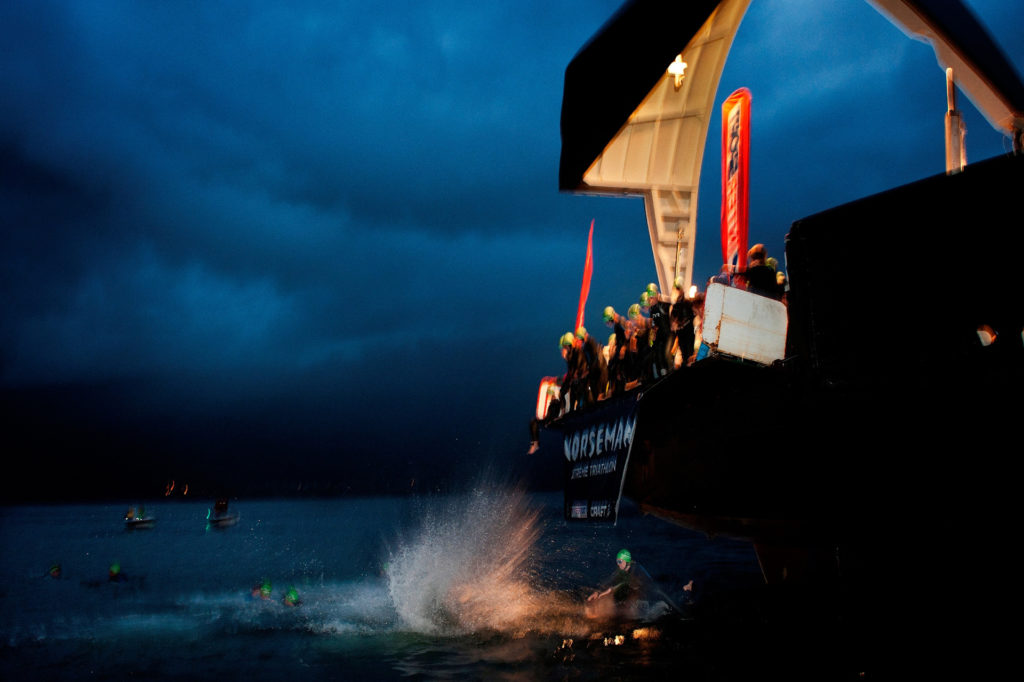
Adelaide: How did preparing for Norseman differ to your preparation for Kona?
Tim: After doing the race, I would have done a lot of things differently!
I did my research, but not well enough. I did quite a few things right. I was always one that it didn’t matter if it was hot or cold. I always went outside and trained. If I stayed in Colorado in the winter, I’d train throughout the winter and in the heat of the summer.
I always felt that if you were fit enough, you could do well in any condition and I always ran trails in the mountains and climbed in the mountains here in Colorado, so I knew that stuff didn’t scare me about the Norseman course.
I would go out in the early spring in May, when the snow has melted, but the reservoirs aren’t quite up to swimming without a wetsuit, and I would go out and swim without a wetsuit, just so I could get used to really cold water.
I knew the fjord and the Norseman swim was going to be really cold and honestly, I don’t like cold water. That was one of those things that kept me from being a swimmer. A lot of the times I just did not enjoy swimming in cold water.
So I tested myself with that, I did a lot of cold water swims and then if it was raining, sleeting or snowing, I forced myself to go out and do really long workouts and that kind of stuff, because I knew that was a possibility on the day.
The one thing I didn’t really know about, and how bad it was, was zombie Hill. I didn’t really get to test that part of the race. I didn’t know that it was basically running up a ski hill road, it was paved, but a ski hill road to got onto the off road part of it. So knowing that, I would definitely have some different roads that I would train on. But I felt like I was pretty well trained for the bike and the swim.
The swim still cracks me up, because on the very first day I was there to do a test swim and I was getting ready to jump in the fjord and I was stressing that it was so cold. And then I saw these two little local kids jump in without a wetsuit and just be playing in the water. And I’m like, ‘Oh, boy, you know, it can’t be that bad.’
Norwegians are tough.
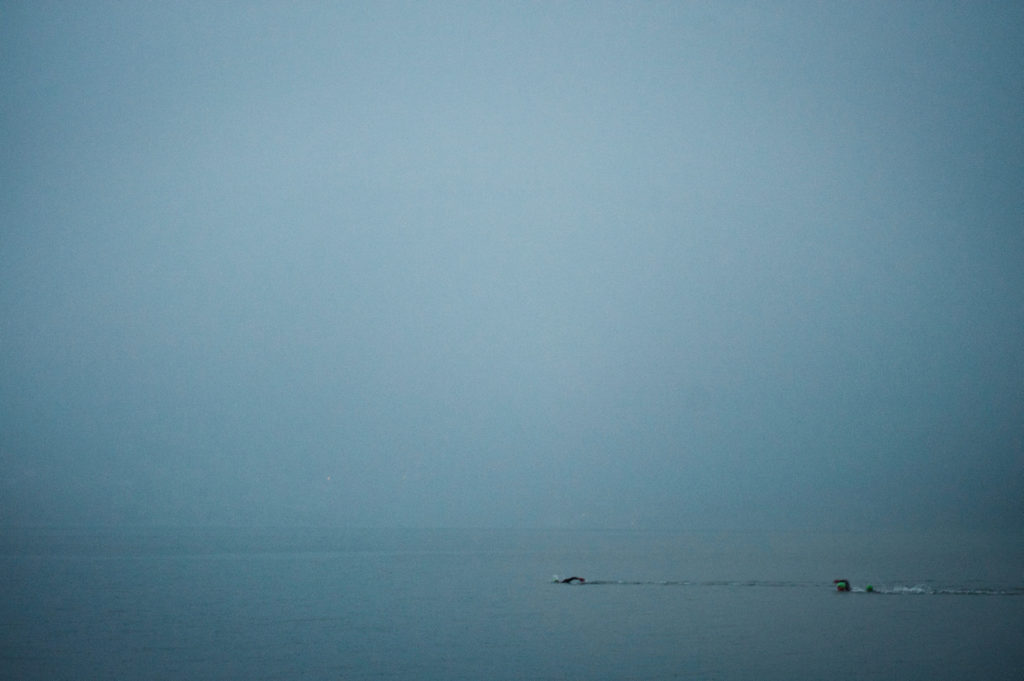
Adelaide: They’re really tough! So was it the cold water and the weather that made you scared about Norseman?
Tim: I would say that was probably the apprehension for me, but it also was exciting.
There’s something satisfying about when you finish the day, like even here training and it’s been raining all day and you get in a six hour bike ride in the rain or the cold. You know it’s something really satisfying and I think it helps you become mentally strong. I wasn’t scared of those conditions, but they were definitely in the back of my head. Like I had to really prepare for it.
I had to have my crew ready with the different clothes that I might need and stuff like that. So there’s a lot of planning that went into it. I enjoyed that aspect of it too. I worked with one of my sponsors on special tops and stuff like that for the race. So it was it was kind of fun to include everybody.
Adelaide: How did you pick your crew?
Tim: I had my brother, he was who I had trained and raced with for most of my career and he was kind of a logical choice to come, because he knew me better than anyone and knew he’d even know what I was feeling emotionally. He can look at my face and be like, okay, he needs more food, or we need to just leave him alone, or we need to psych him up or something like that. So he was an obvious choice.
Then I brought a friend who is a photographer and videographer. We thought it’d be pretty cool to document it and for my sponsors. We were excited to have him on board, so we could really share with my community and with the world what Norseman was all about. Some of that stuff turned out amazing. We got a lot of good press out of that and he was also such a good friend, that it was fun to have those two around.
Adelaide: That’s awesome. Do you have any tips for those racing this year when it comes to picking and organising their crew? So they know what to do when certain things happen or during some parts of the race?
Tim: Yeah, we sat down several times before the race and we all flew together. So spend some time with your crew. Let them get to know you. If it’s your family, like my brother knows me, but I would never have had my wife come and crew for me, Just probably wouldn’t have been a good situation! And I didn’t spend all of those years training with my wife, but I did with my brother. So these people that know you and know some of your emotions and stuff like that, I think would be great. The key is that they’re there for you.
Sometimes I think if my wife had been there, I’d be looking out for her, like asking if she was doing okay. But you put in a lot of training for something like Norseman, so your crew is very important.
I was probably even unprepared a little bit with my crew. It’s hard to travel from the US to Eidfjord and have everything dialled in. I was lucky that the Norseman crew were kind and helped me out a little bit, just having some extra wheels and stuff like that, because travelling with everything was was difficult.
I would say make lists after lists after lists of everything you may need and then have stuff that you may think you would never use, but have it in the car anyway. Sometimes those Doritos at mile 50 into the run tastes really good!
Adelaide: Was that your favourite snack?
Tim: No, I just threw that out there! I had all different kinds of stuff. It was so cold in the swim and in the first half of the bike we had rain and sleet, and even I think some snow on a couple of the passes, and definitely when it’s cold like that, solid food works much better for me than like gels or drinks. So I had lots of snicker bars and power bars and stuff like that.
Adelaide: Snickers seem to be quite a popular choice with pro triathletes!
Tim: They just work so well and they never taste bad! Even in Hawaii when they completely melted, you could just kind of squeeze them into your mouth and they tasted good. It’s gonna taste way better than a soft overripe banana!
Adelaide: Oh my gosh, yes. I don’t think there’s any competition there!
Tim: Exactly.
Adelaide: So talking about training, in 2011 you were the first non-European to win Norseman, which is amazing. Did you train to win or were you training to see if this is something I can do?
Tim: I was training to finish, I had learned the hard way once in Hawai’i when I DNF’d (Did Not Finish) and it’s the only race that I ever did that and it’s not a good feeling. So my first priority for any event that I ever enter is to finish and sometimes people overlook that, especially if you’ve done multiple Ironmans.
With everything that I’d done, I was like ‘I can finish an Ironman’, but my primary goal was to finish Norseman. I knew if I trained hard enough, in the way that I trained, I could be competitive, but I had absolutely no idea of my competition and their abilities.
I started getting a little bit of an idea when I arrived in Norway. It’s just some information on some of the other athletes and it was their home event, these guys had done it before and knew everything about it. So I didn’t expect to win. But I wanted to be competitive. I wanted to push myself and I had tried to train hard enough to be competitive.

Adelaide: What was your standout moment on the race?
Tim: The start is pretty daunting and amazing.
I was lucky that my friend who was part of my crew, was one of the videographers and so he had permission to be on the boat.
To have him out there and to capture some of the moments of me right before jumping into the water, that’s a pretty unique experience, jumping into that water in the pure dark. I remember that really well.
A lot of the race is kind of a blur. I remember really enjoying parts of it. I never really reached the point where I was like, this stinks or I’m really tired. I was really tired, but I was still kind of in awe of what I was doing at that point.
Then crossing the finish line, the last little bit when I knew I was going to win. I just remember crossing the finish line and being more tired, like sleepy tired, than I had ever been crossing a finish line. I literally crossed the finish line, sat down and started closing my eyes. Just kind of sitting there. Looking back, it was kind of comical. It was my longest Ironman race that I’d ever done and it was just kind of funny. My friend who was with me just chuckled. He’s like, ‘Dude, I think you were just sleeping on my shoulder.’
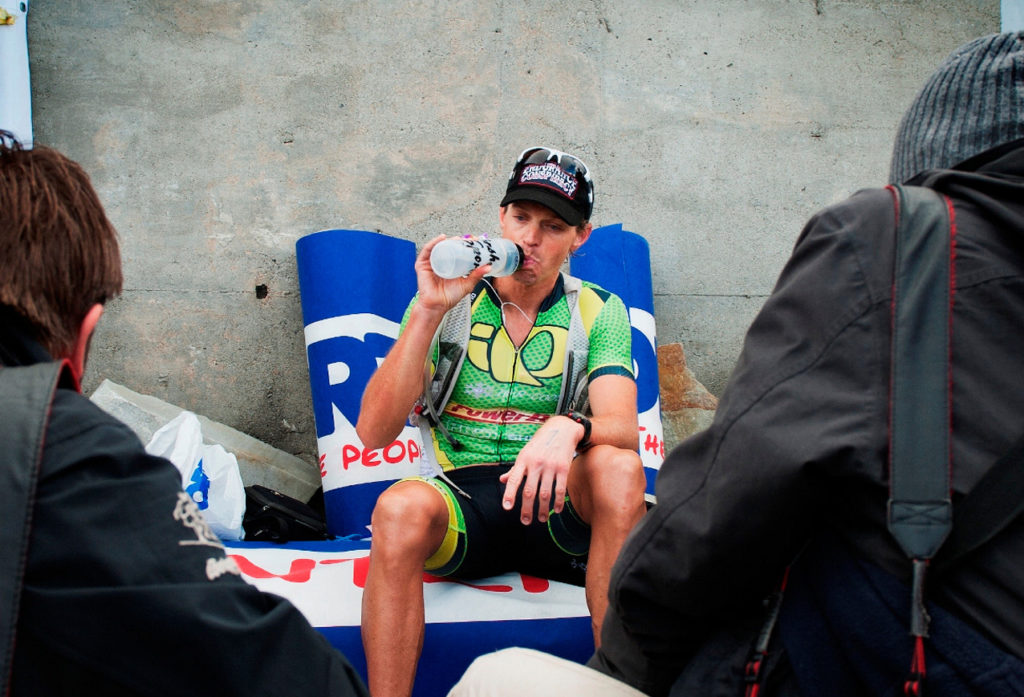
So those moments stand out to me and then the after party, when it just kind of goes through the night as everybody’s finishing. That’s such a brilliant experience. I ate some dinner, went back, took a nap, came back out at like one in the morning and ate some more! It was just such a fun experience.
Adelaide: That’s really incredible, and how did it compare to Kona?
Tim: Norseman was a very different experience, it is more of the reason I got into the sport to begin with. It’s can I do this? More low key and more grass roots and that was kind of what triathlon was like when I got into it.
Ironman Hawai’i was well established in 1992, but it was very different than it is today. It wasn’t corporate like it is today and wasn’t such a big production.
In all honesty, Norseman kind of ruined it for me – in a good way. I finished that race and I knew nothing was going to compare to that again. It gave me almost permission to end my career there.
I kind of did, I went and did a couple of years after that, but that was my last major competition and last Ironman competition.
It was very satisfying to end there, because I knew that I could go Back to Hawaii and probably win, but it wasn’t going to really compare to the emotional satisfaction that I got from just competing and winning Norseman.
It was such a unique experience. I talk about it so much with most of the people that I know and as I mentioned to you before, always in any talk that I do, I get more questions about Norseman than I do about Hawai’i!
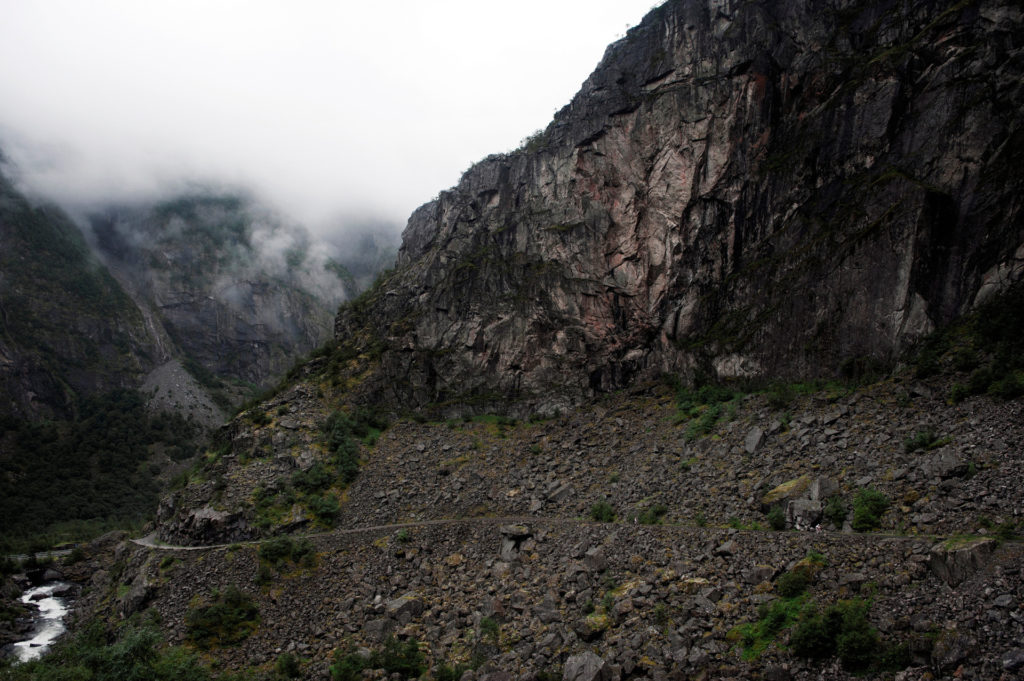
Adelaide: That’s really wonderful. What’s your top recommendations for people training for Norseman?
Tim: I would say stay present during the race, just enjoy the race. Don’t look ahead too much.
Enjoy the race with your crew. It’s such a unique experience to have your crew following you along this course. You don’t get that at any other event, where you get to share this experience with whoever’s with you, whether it’s family, friends or kids. They get to be a big part of what you’re doing and think that unique aspect, is what Norseman is all about.
Going into it, it can really be a group event. Obviously the hard work falls on you, but even in my training, my brother and my friend that was with me, would follow me along. We could chat about things leading up to the event.
So I think that’s one part of it, to just be really present and enjoy racing there. It’s hard to even call it a race, but just participating in something so neat and unique.
Then really train, expect the worst and train for it. Like I said, I would train differently now knowing the race and seeing how it is planned out. Expect bad conditions, expect more elevation gain than there is and just really go out and push yourself in training and then once you leave your house and head to the race site, relax and enjoy it. Every part of the course is just beautiful, so I can’t say enough good stuff about it.
Adelaide: So how would you train differently for Zombie Hill if you were to race Norseman again?
Tim: I just didn’t realise Zombie Hill was such a long continuous climb and how steep it was really reminded me of these roads that we have in Colorado, that lead up to the ski resorts where they’re just switch back after switch back and I just hand’t looked at the information clearly enough, but when I hit that, I was like, ‘Whoa, this is different!’
I got into power hiking and running back and forth, back and forth and we had gone from freezing rain to bright sunshine at that point. So it was really hot. It was just one of those things that caught me off guard, but I have roads now that replicates Zombie Hill here in Colorado and I would be training on those for sure.
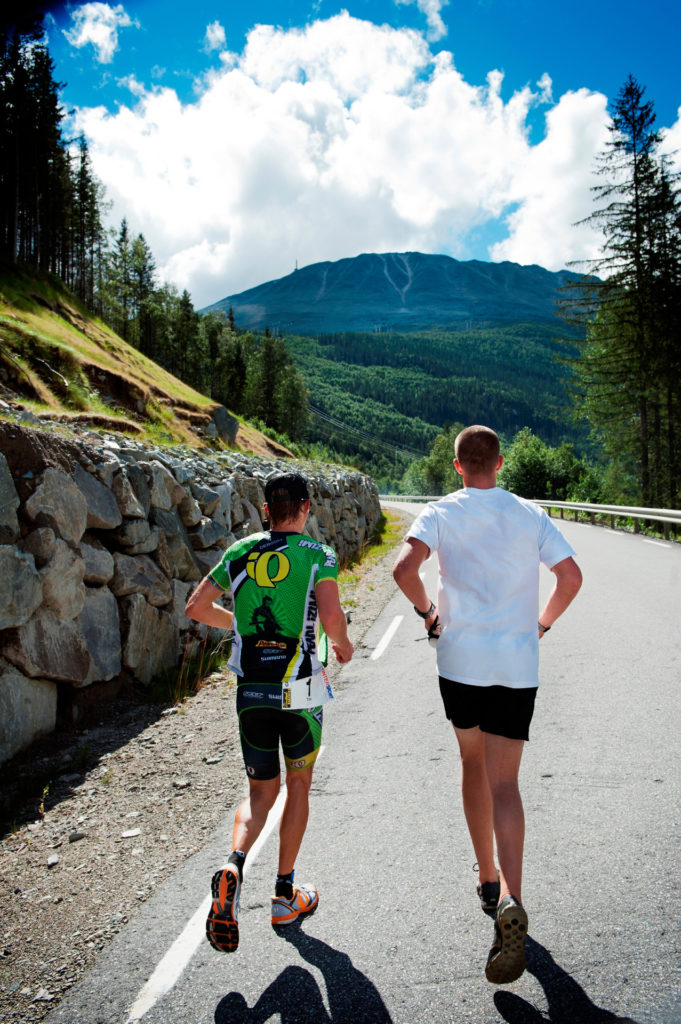
Adelaide: So if triathletes don’t want to be so shocked by Zombie Hill, but be well trained for it, you recommend finding a road that kind of simulates Zombie Hill?
Tim: I would, definitely. Find the steepest continuous road and I know that’s tough if you live somewhere where there’s no mountains, but do hill repeats or get on a treadmill and rack it up
to 10% to 12% and just run for a while, because it was a daunting hill!
Nowadays I now that I pretty much run all trails up hill anyway, that’s pretty much what I do. It’s not as daunting, but coming from a pure triathlon background, where most courses are kind of just rolling, I think most competitors will get a little daunted by seeing Zombie Hill.
Adelaide: The first year I was working for Norseman, we drove up Zombie Hill and I couldn’t believe how steep it was!
Tim: We got halfway up it and somebody in the car from the organisation said, ‘Well, this is about halfway up Zombie Hill!’.
I was like, ‘Wait, we run up this?!’ I hadn’t even realised it at that point. So that’s when I was like, ‘Okay, okay, this is going to be a little different’.
At the start of Zombie Hill I put headphones in with music and that was nice. I remember having my music ready to go and I just put my headphones in, put my head down and got up that thing.
Adelaide: Yeah, I think that’s the best technique. Did you have a song or playlist that really psyched you up and kept you motivated?
Tim: Yeah I had a motivational playlist ready to go, but in all honesty, I hit repeat and had the same song going the entire time up Zombie Hill. It was so funny, because my friend that was with me, he’ll still send me a message or something with that song on it and just be like, remember this? It was a Rage Against The Machine song. Very, very angry song that was supposed to motivate me. It worked. It worked. I still love that song and when it comes on, it brings me right back to Zombie Hill.
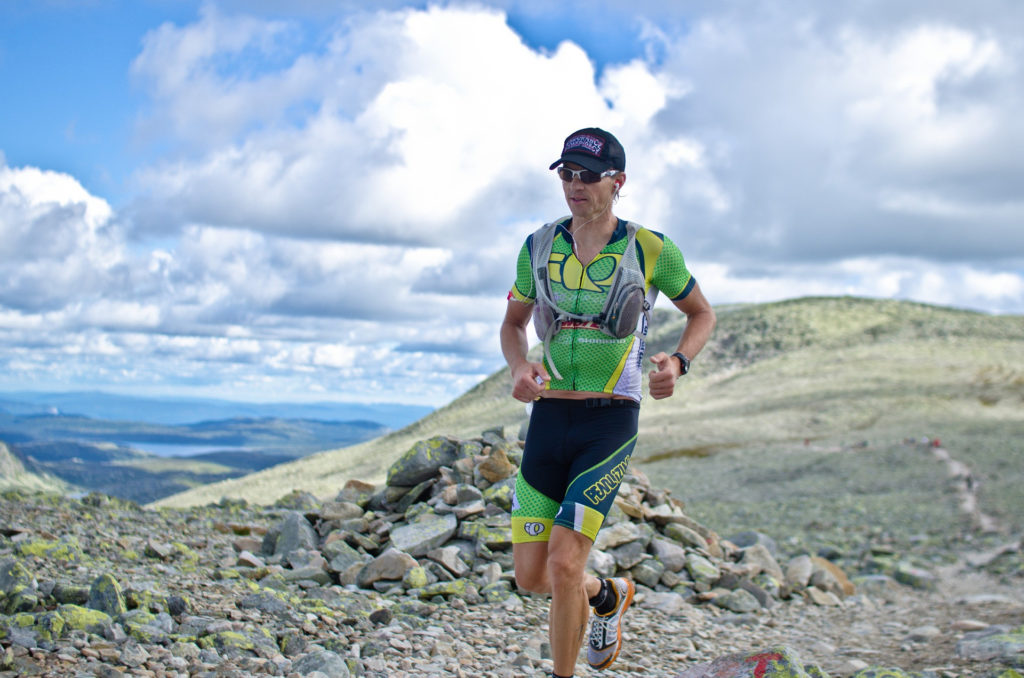
Adelaide: Do you think in the future you’ll race Norseman or another Xtri race?
Tim: I’ll never say never. I don’t swim much anymore. I’ve really embraced the winter sport. So I’m a back country skier, ski mountaineering and cross-country skier. I need to come over to Norway and do some some cross-country skiing. Some of the back country skiing up in the fjords and stuff like that is more on my list than to do Norseman again, but I’ll never say never.
It was such a great experience and I’ve heard good things about some of the other extreme races, Swissman and stuff like that are all appealing, but I’d have to find some motivation to get back in the water again.
I still ride and run all of the time, almost daily in the summer, so that wouldn’t be an issue and if it’s on courses that are like Norseman, then I enjoy that kind of stuff still, but the swim, I’d have to muscle my way through that.
Adelaide: I think most people find the swim the least appealing and it tends to be the discipline that holds people back.
Tim: Yeah, for me, I spent so many years swimming in a pool and looking at the black line that you I kept saying, ‘When I’m done with college swimming, I am done for good.’
Then 15 years later of triathlon, I’m like, ‘Okay, now I can finally be done with swimming.’
The only time I find myself swimming these days is if I’m in open water, like we went to Hawai’i last year, and I swam every day, but now I probably won’t swim again for a year.
Adelaide: Unfortunately we’re going to have to wrap up, but we do have time for the quick fire round!
When you think of Norseman, what’s the first thing that comes to mind?
Tim: Swimming in the fjord.
Adelaide: Which three athletes would you love to see compete in Norseman?
Tim: I would like to see Jan Frodeno (@janfrodeno), Cameron Wurf (@cjwurf) and Lionel Sanders (@lsanderstri).
I don’t want to leave the ladies out though, so I think I would like to see someone like Daniela Ryf (@danielaryf). I think she’s just hard as nails and would probably crush it.
Adelaide: Well thank you so much for coming on the radio. It was really wonderful to have you on!
Tim: Oh, no problem. My pleasure. Like I said, Norseman is one of those events that I would do anything for. It’s such a unique, amazing place. Thank you so much.
——-
About Adelaide Goodeve
Adelaide is a member of the Norseman media team. She also works as an “mental fitness” coach. Find out more about Adelaide here.
About Tim DeBoom
Tim is a ex-professional triathlete from America whose career spanned almost 20 years. In 2001 and 2002 he won the the Ironman World Championships and in 2011 went on to win Norseman, becoming the first non-European to do so! He’s since been a stay at home dad, personally training people and adventuring in the Colorado mountains! If you’d like to connect with Tim, then you’ll find him on Instagram: @timdeboom
——-
About Norseman Radio
If you’d like to listen to interesting and intriguing stories around the Norseman Xtreme Triathlon and fully immerse yourself in the experience, then Norseman Radio is for you.
This podcast is not just for those who’d like to jump off the car ferry into Eidfjord and run up Zombie Hill.
You can find Norseman Radio on:
Connect with us on Instagram, Facebook, on our website and by signing up to our email newsletter!
